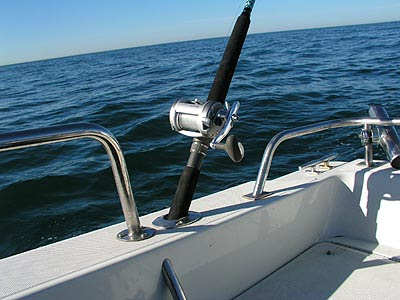Trolling reels are typically used for offshore big-game trolling in open water.
Trolling is the process of dragging both bait and lures behind a moving vessel, which is a productive way to locate schools of migratory fish. The reason being, when a boat trolls over a school of fish, the wake and commotion on the surface emulates a ball of bait. This triggers the feeding instincts of many offshore species and immediately sends the leading edge of the school towards the commotion to investigate, with the rest of the pack following. As the most aggressive fish in the school frantically try and chase down this commotion, the trolling lures, jigs and baits are the first hint of a meal that they come across. They charge at them with reckless abandon, inhaling what appears to the fish as vulnerable stragglers, desperately trying to catch up with the rest of the pack.
As soon as one of the trolling lures or baits is inhaled, the trolling reel begins to sing, with the clicker of the reel creating a loud noise that notifies the angler to get ready. This sends the anglers into a dash for their gear, yelling "hook-up", which immediately causes the captain to throw the vessel into neutral to stop the boat. As the momentum of the vessel carries the boat forward, the crew begins to throw live bait, either by pieces or in full scoops. By now, the rest of the migrating school has caught up to the commotion and is met with the temptation of live bait, sending them into a feeding frenzy.
However, a wide-open bite is not always the result of a hook-up while trolling. When the fish are down, or when the conditions are far from ideal, trolling will produce the majority of the catch, with no feeding frenzy following the trolled up fish. On these days, it is essential to land every troll fish and having the right equipment is critical in accomplishing this. Trolling rod and reel combos are the most expensive combos on the market today. Due to their importance in locating roaming schools of open water fish, manufacturers like Shimano®, Penn®, Daiwa®, Okuma® and Accurate® incorporate the finest materials and technologies to ensure strength and durability in producing the best fishing reel capable of handling record-breaking trophies.
Trolling reels are typically found in the lever drag system. On these types of fishing reels, the drag pressure adjusts with the slide of a lever, which is located on the top of the reel to the right. Designated markings of, or similar to freespool, strike and full are found on reels like the Penn® International series, Shimano Tiagra® and the Acurrate Twin Drag® saltwater trolling reels. Most later models come in a two- speed version, with two separate gear ratios that serve different purposes. The high gear is to gain as much line as possible with every turn of the handle, sacrificing torque and power. Low gear, on the other hand, provides tremendous torque and in return, sacrifices the ability to retrieve a substantial amount of line per crank. When properly utilized, both gears are designed to maximize the chances of quickly and efficiently landing scale-busting size fish.
The most noticeable difference in a trolling reel are the two rings that sit atop all trolling fishing reels. These rings are part of the frame and hold an enormous amount of strength. Trolling straps are attached through these rings, as well as big game harnesses and on some occasions, a back-up rod and reel combo, a common practice when fishing on long range boats out of San Diego for huge bluefin and yellowfin tuna. Trolling reels are so strong and powerful, I have even seen anglers cut these rings off and even go so far as to make custom frames to readily access the spool and use trolling reels as live bait reels. I do not recommend this practice, as many of the latest star-drag conventional reels will serve the same purpose.
With the high prices of fuel, trolling around in offshore waters can be very costly. That is why every serious big-game angler should consider having the best saltwater tackle available when it comes to their arsenal. The properly maintained saltwater combo can mean the difference in coming home with a trophy of a lifetime, or coming home skunked, carrying an empty sack.
I have been fishing for over 20 years of my life and hope to continue to do so for the next 30. I have dedicated myself to sharing what I have learned through those years in the hopes of promoting this popular outdoor recreational activity by providing commentaries and reviews, video tutorials, fishing tips and more. Come visit my site at http://spinningreels.com for freshwater and saltwater fishing information.
Article Source: http://EzineArticles.com/?expert=Henry_Yoo

